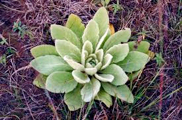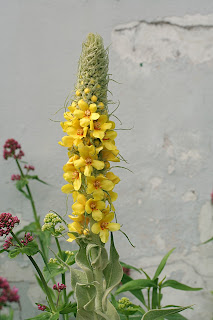Did you know that there are many herbs that have been traditionally used for smoking besides Cannabis? Native American tribes and indigenous cultures throughout the globe have smoked a huge variety of herbs including bearberry, spearmint, comfrey, willow bark, catnip and many others for both medicinal and ceremonial purposes.
One of the smoking herbs that is most easily identified for beginning wild crafters is Mullein. The botanical name for the Mullein we see in our fields here in Michigan is Verbascum Thapsus. There are numerous types of Mullein with different botanical names. The name “Mullein” would be referred to in text books as it’s “common” name. Wild crafting is the term herbalists use for the act of seeking and harvesting an herb from its natural habitat in the wild.
Mullein is a biennial plant. That means that the plant lives for two years. The first year the plant grows a rosette but no flower stalk. The rosette survives through the winter and the flower stalk grows the second year. Then, bees pollinate the small yellow flowers along the stalk which results in a large dark seed head by autumn. The plant then drops the seeds so that the following spring new rosettes will grow, restarting the cycle.
Mullein is typically found in open fields. It would be unusual to find it in deep woods or swampy areas. The plant prefers poor sandy soil but will grow in pretty much any kind of dirt. I’ve taken seed from the fields to my home garden and successfully propagated it there.
 |
| Here is what a first year flower looks like. |
The seed heads from the previous year will be standing tall on their stalks... this can be a great way to locate the low lying rosettes. Find a field where you see the tall seed heads and begin walking slowly and carefully through the long grasses looking down at the ground.
When you locate a rosette, carefully remove the inner leaves and put them in a basket or paper bag. The outer leaves are usually sandy and hard to dry properly. If you are gentle and you just pluck a few of the center leaves the rosette will survive the season and grow new leaves for you to harvest until winter. A responsible wild crafter should only remove a small portion of the plant medicine at any site. If you take it all, Mother Nature will not be able to keep growing it for you.
Additionally, it is wise to distribute seeds from seed heads any time you are able. Just give the seed head a good pull between your fingers and the seeds will fall free. Every time you distribute seeds you are perpetuating the cycle of growth for the plant, assuring future generations will be able to benefit from the herb too.
It is very important to note that gathering Mullein on a wet day or when the morning dew is still wet on the leaves can really interfere with proper drying. It is best to wait until the dew has evaporated and always on a dry day. Never gather plants intended to be dried on a rainy day. Your chances for mold developing during the drying process are far greater if you gather during wet weather. Gathering with plastic bags, or closed containers also can contribute to spoilage. If you intend to dry an herb always collect it in a container that allows moisture to evaporate. Trapping moisture will create problems.
Mullein looks fuzzy and soft. It is not so much fuzzy and soft as it is prickly. Those little hairs can make you itchy. If you happen to get itchy just hit the shower. The little hairs will wash right off. If you were to consume the Mullein leaves internally you would want to sift the hairs off. Ayurvedic healers native to India traditionally sift the Mullein intended for human consumption. Those little hairs could make your insides feel itchy too. I recommend buying the herb sifted as it is a difficult process. Not impossible, just difficult. I am sure it can be accomplished. I just haven’t done it myself.
 |
| 2nd year plant in bloom. |
It is important to note that vaporizing or smoking Mullein leaves will not make you itchy. Only large scale skin contact (over a large portion of the body, not just your fingers and hands) and consumption would result in possible irritation. Handling the plant with your fingers and hands during harvest and processing would be unlikely to cause irritation.
Ok, so now you have a basket full or paper bag with your carefully harvested inner leaves from the Mullein plant. The next step is to dry them. If you have gathered many leaves you may want to use a screen. You would prop it up so that the screen allows for air flow underneath it. Then you would want to spread your leaves out in a single layer on the screen. Don’t pile them up, that will trap moisture and cause improper drying.
A fan or dehumidifier in the room can help but it is not necessary. The key is to keep dust, pet hair, dirt, etc. away from the leaves as they dry. If you have just a few leaves paper plates work great. You would just spread a single layer on a few paper plates and set them in a clean place to dry.
It is best to turn the leaves once a day for a week or so. If the weather is humid it could take longer. When you can pick up a leaf and hear it snap like a potato chip as you break it you can be assured it is dry enough to store. If you don’t hear it snap... it’s not dry enough yet. Depending on your preference you can store the dried leaves in a glass jar or a paper bag. The paper bag will assure that no trapped moisture will interfere with storage. If you use a jar be absolutely certain you have achieved the proper dryness before you seal it.
In addition to being a relaxing smoking herb with no known drug interactions or side effects besides slight sedation Mullein has very useful medicinal applications.
The flowers from the mature second year flower can be soaked in oil to make a healing preparation with a huge variety of uses. The oil has been found to have anti-microbial action as well as pain relieving properties. Mullein oil has been used historically to aid in the healing of ear infections. Many natural healers still rely on Mullein oil today. (1)
The leaf you have harvested and dried has many medicinal properties too. It is a well-known expectorant with anti-inflammatory properties. It can be used in a vaporizer or rolled to smoke. Individuals who suffer from Asthma may find vaporizing Mullein to be helpful. I have several friends with Asthma who rely on the daily use of Mullein to help ease their symptoms.
Mullein can be mixed with other smoking herbs. Among those, a good companion herb is Cannabis. There have been many studies done to determine the usefulness of both Mullein and Cannabis as potential natural treatments for the symptoms people with asthma and other lung congesting conditions. “Marihuana smoke, unlike cigarette smoke, causes bronchodilation [expansion of the air passages] rather than bronchoconstriction [narrowing of the air passages] and, unlike opiates, does not cause central respiratory depression.”(2) The small inner leaves of the Mullein plant, properly dried, and mixed with Cannabis for smoking may be very relieving to a person with lung congestion.
Many Cannabis smokers find that the marijuana they smoke can make them cough regardless of how well it has been grown and cured. Often, I have found that individuals with this common complaint are sometimes able to alleviate the coughing by adding a small quantity of Mullein to their joints or pipes.
Every person has their own unique experience with healing herbs. Some people find Mullein’s sedative actions to make them feel like taking a nap. This effect can be minimized by carefully choosing the strain of Cannabis to combine with the Mullein. Often using a strain with more Sativa content can offset the sleepiness.
Most years my best friend and I are able to gather enough Mullein to carry her through the winter in a matter of hours. She uses one or two small leaves of Mullein every day to offset her asthma symptoms. We store one large paper grocery bag of dried Mullein leaves in her pantry every fall. By the time we are able to gather again she usually has a small supply remaining.
I hope you find the information in this article helpful and inspiring. If you take the time to wander an open field this summer perhaps you will find some Mullein. Even if you don’t gather it for harvest, please... take the time to spread some seeds for future generations.

Rebecca Veenstra is a Chartered Herbalist and founder of New World Seeds in Traverse City, MI
Sources:
(1) Blumenthal M, Busse WR, Goldberg A, et al. (eds). The Complete Commission E Monographs: Therapeutic Guide to Herbal Medicines. Boston, MA: Integrative Medicine Communications, 1998, 173.
(2) The New England Journal of Medicine, 1973 study titled “Single-Dose Effect of Marihuana Smoke. Bronchial Dynamics and Respiratory-Center Sensitivity in Normal Subjects,” by L. Vachon et al.,

